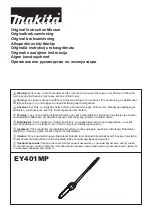
-8-
Additional Safety Rules
i. Do not reach beyond table saw base. Keep your
hands away from the spinning blade.
j. Use the saw-blade guard and spreader for every
operation for which it can be used, including all
through sawing.
KNOW YOUR CUTTING TOOLS
Dull, gummy or improperly sharpened or set cutting
tools can cause material to stick, jam, stall the saw,
or kickback at the operator. Minimize potential injury
with proper cutting tool and machine maintenance.
NEVER ATTEMPT TO FREE A STALLED SAW-
BLADE WITHOUT FIRST TURNING THE SAW
OFF.
a. NEVER use grinding wheels, abrasive cut-off
wheels, fric tion wheels (metal slitting blades) wire
wheels or buffing wheels.
b. USE ONLY RECOMMENDED ACCESSORIES.
c. Crosscutting operations are more conveniently
worked and with greater safety if an auxiliary wood
facing board is attached to the miter gauge. See “Rip
Fence Auxiliary Facing.”
d. Make sure the top of the cutting tool rotates toward
you when standing in the normal operating position.
Also make sure the cutting tool, arbor collars and
arbor nut are installed pro p erly. Keep the cutting tool
as low as possible for the oper ation being per-
formed. Keep all guards in place whenever possible.
e. Do not use any blade or other cutting tool marked for
an operating speed less than 5000 R.P.M. Never
use a cutting tool larger in diameter than the diame-
ter for which the saw was designed. For greatest
safety and efficiency when rip ping, use the maxi-
mum diameter blade for which the saw is designed,
since under these conditions the spreader is near est
the blade.
f. Make sure the table insert is flush or slightly below
the table surface on all sides, except for rear side.
NEVER oper ate the saw unless the proper insert is
installed.
THINK SAFETY
SAFETY IS A COMBINATION OF OPERATOR
COMMON SENSE AND ALERTNESS AT ALL
TIMES WHEN THE TABLE SAW IS BEING
USED.
Do not allow familiarity
(gained from fre quent use of your table saw) to
become com mon place. Always remember that
a careless fraction of a second is sufficient to
inflict severe injury.
The operation of any power tool can result in
foreign objects being thrown into the eyes, which
can result in severe
eye damage. Always
wear safety goggles
that comply with ANSI
Z87.1 (shown on pack-
age) before commenc-
ing power tool
operation.
Some dust created by power
sanding, sawing, grinding,
drilling, and other construction activities con-
tains chemicals known to cause cancer, birth
defects or other reproductive harm. Some exam-
ples of these chemicals are:
• Lead from lead-based paints,
• Crystalline silica from bricks and cement and other
masonry products, and
• Arsenic and chromium from chemically treated lum-
ber.
Your risk from these exposures varies, depending on
how often you do this type of work. To reduce your
exposure to these chemicals: work in a well venti-
lated area, and work with approved safety equip-
ment, such as those dust masks that are specially
designed to filter out microscopic particles.
Before each use, review all warnings
located on the table saw.









































